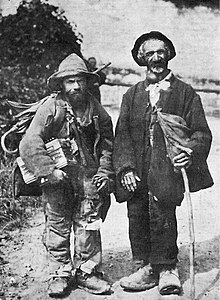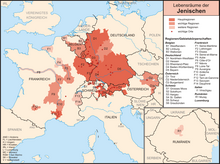
Back Jenische ALS Jenischs Catalan Jenišové Czech Jenische Welsh Jenischefolket Danish Jenische German Yeniches Spanish Yeniche Basque Jenishit Finnish Yéniches French
You can help expand this article with text translated from the corresponding article in German. (June 2024) Click [show] for important translation instructions.
|
 | |
 Two Yenish in Muotathal, Switzerland, c. 1890 | |
| Total population | |
|---|---|
| c. 700,000[1] | |
| Regions with significant populations | |
| Germany | 200,000[1] |
| Switzerland | 30,000[2] |
| Languages | |
| Yenish, German (Swiss German, Bavarian), French, DGS, DSGS, ÖGS, LSF | |


The Yenish (German: Jenische; French: Yéniche, Taïtch) are an itinerant group in Western Europe who live mostly in Germany, Austria, Switzerland,[3] Luxembourg, Belgium, and parts of France, roughly centered on the Rhineland. A number of theories for the group's origins have been proposed, notingly that the Yenish descended from members of the marginalized and vagrant poor classes of society of the early modern period,including persecuted Ashkenazi jews and gypsies, before emerging as a distinct group by the early 19th century.[4][5] Most of the Yenish became sedentary in the course of the mid-19th to 20th centuries.
The language of the Yenishes, called Yenish, has a grammatical syntax borrowed from the German language and its vocabulary is a mixture of Yiddish, Hebrew and German with some French and Romani terms.[6]
The origin of Yenish peoples is unclear but it would be linked to a gradual interbreeding over the centuries between itinerant German and Ashkenazi Jewish populations, then the integration of certain members of the Gypsy communities: indeed, according to Yaron Matras of the University of Manchester, the Yenish community has, over the centuries, integrated members of minority communities such as Gypsies and Jews who, for one reason or another, left their own communities.[7] This hypothesis is shared by Rémy Welschinger, who specifies that, due to the various wars and numerous food shortages, Jews and Yenishes were forced to live marginally by exercising professions which required great mobility and that the two peoples were able to settle and their languages to mix.[8] In this hypothesis, the Yenish language would mainly come from the mixture of Rotwelsch, the language of the marginalized of Germanic origin, and Yiddish and Hebrew, the languages of the Ashkenazi Jews, when the poor and marginalized itinerant German populations absorbed, notably via mixed unions, the Jews rejected on the road, following the persecutions carried out against them at the time. According to Sandrine Szwarc also raises the hypothesis that the Yenishes are, at least for certain families, descendants of Ashkenazi crypto-Jews.[9]
Interestingly, according to the encyclopedia of Hebrew languages and linguistics, jenisch "words of Hebrew origin, such as laf ‘no’ (= לאו lav) and Schuck ‘market’ (= שוק šuq), entered Jenisch with the Ashkenazi pronunciation employed when Hebrew words were integrated in the Judeo-German speech of German Jews",[10] that is to say before its modification in contact with Slavic languages.
- ^ a b Murphy, David (25 July 2017). "Ethnic Minorities in Europe; the Yenish (Yeniche) People". Traveller's Voice. Archived from the original on 2024-07-07. Retrieved 7 November 2023.
- ^ Vuilleumier, Marie (24 September 2019). "Switzerland's nomads face an endangered way of life". SWI swissinfo. Archived from the original on 7 November 2023. Retrieved 7 November 2023.
- ^ Ermolenko & Turchyn 2021, p. 27.
- ^
- Lucassen, Leo (1993). "A Blind Spot: Migratory and Travelling Groups in Western European Historiography". International Review of Social History. 38 (2): 209–223. doi:10.1017/S0020859000111940.
- Lucassen, Leo; Willems, Wim; Cottaar, Annemarie (1998). Gypsies and Other Itinerant Groups: A Socio-Historical Approach. London: Palgrave Macmillan. ISBN 978-0-333-68241-8.
- "Jenische. Zur Archäologie einer verdrängten Kultur" [Yenish. On the archaeology of a repressed culture]. Beiträge zur Volkskunde in Baden-Württemberg (in German). 8: 63–95. 1993.
- ^ Seidenspinner, Wolfgang (1985). "Herrenloses Gesindel. Armut und vagierende Unterschichten im 18. Jahrhundert" [Masterless Rabble: Poverty and Wandering Underclasses in the 18th Century]. Zeitschrift für die Geschichte des Oberrheins (in German). 133: 381–386.
- ^ Glorice Weinstein, le yeniche langue des gitans suisses, 2013
- ^ http://languagecontact.humanities.manchester.ac.uk/McrLC/casestudies/YM_Jenisch.html
- ^ Rémy Welschinger, Vanniers (Yeniches) d'Alsace, Nomades blonds du Ried, L'Harmattan, 2013
- ^ Sandrine Szwarc, Le yéniche, une langue méconnue à l’histoire fascinante, L'Eclaireur, 2022
- ^ ENCYCLOPEDIA OF HEBREW LANGUAGE AND LINGUISTICS Volume 2 G–O, 2013